Self-propelled artillery installation M40 Gun Motor Carriage (USA)
Perhaps the main problem with the M12 self-propelled guns, studied at the end of 1943, was the used chassis. The project started back in the early forties and was based on the latest technology of the time. The M12 GMC chassis was a redesigned M3 Lee tank with all the advantages and disadvantages. In the future landing in Europe, it was not planned to use the “Lee”, which is why self-propelled guns could have problems with maintenance. It required a similar technique based on newer tanks M4 Sherman. At the very end of the 43rd there was an order to develop self-propelled guns based on the Sherman tank, armed with a 155 mm gun of the M1A1 or M2 type. The project received the designation T83 Gun Motor Carriage.
Experience in testing and some exploitation of the M12 self-propelled gun showed that their overall appearance met all the requirements and ensured the fulfillment of all the tasks assigned. For this reason, when developing the T83 project, it was decided to use all existing ideas concerning the layout of the units and the architecture of the combat vehicle. This approach to design was facilitated to some extent by the fact that the base tanks M3 and M4, despite all the differences, had a similar layout with aft engine and front engine compartment.
As a basis for the T83 ACS, the M4A3 medium tank chassis was taken, which met all the requirements both in terms of performance and novelty. In addition, the tanks of this model were built in a large series and actively exploited by the troops. Thus, in the foreseeable future, the lack of spare parts for repair and maintenance was completely eliminated.
In the new project, it was proposed to use the basic layout solutions borrowed from the previous one. So, in front of the body should leave the control compartment and transmission units. Behind them it was planned to install the engine, removed from the stern, and the stern of the hull was given to accommodate the fighting compartment. This arrangement ensured optimal placement of weapons, and also allowed to do without radical modifications of the hull.
The hull of the base tank retained some units, but some of its parts had to be redone. The lower frontal part of the body had a thickness from 51 to 108 mm. Other hull elements were up to 25,4 mm thick. Used armor protected from rifle bullets weaponsand could also withstand hitting some artillery shells. However, in terms of protection, the T83 was noticeably inferior to the M4 tank, which was associated with the intended method of combat use. Direct fire and collisions with enemy armored vehicles were not considered its main task.
In front of the SAU hull, as in the case of the base tank, the control compartment and the transmission compartment were located. In the department of management placed two jobs for the driver and the commander. Behind them was the engine compartment, in which the gasoline engine Continental R975 C4 hp was placed. It is noteworthy that the engine M340A4 used an engine of a different model. Due to the change in the overall layout of the machine, some modifications have been made to the transmission. The engine was connected to the mechanisms in the front of the case with a propeller shaft, which was shorter in comparison with the Sherman units. Similar layout solutions were used in the M3 GMC project.
The propeller shaft of the engine was connected to a five-speed manual gearbox and other units transmitting torque to the front drive wheels. The controls remained the same: the driver had two brake levers, a gear shift lever, and a set of pedals.
Self-propelled gun T83 received chassis based on the type of suspension HVSS. It was equipped with three carts with two road wheels on each side, equipped with shock absorbers with horizontal springs. Already during the tests of the base tank, the HVSS suspension showed its advantages over other systems, such as a lower specific load on the ground or greater reliability.
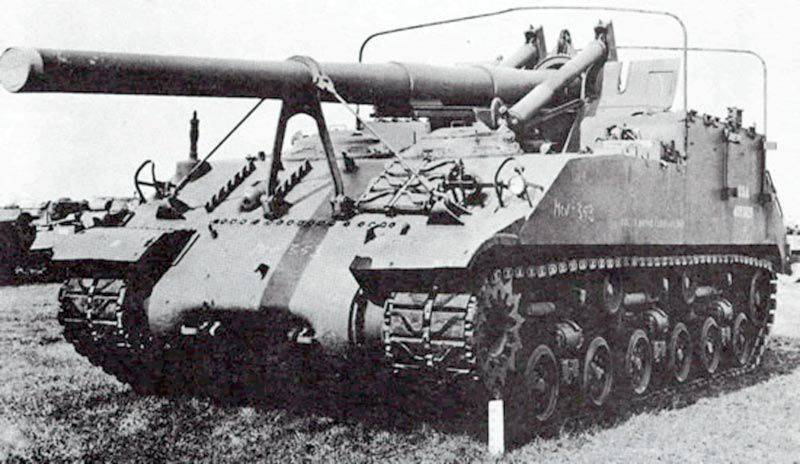
Serial self-propelled gun. Photo Militaryfactory.com
In the stern of the hull, in place of the engine compartment of the tank, they placed a platform for weapons, ammunition and crew. The width of the platform corresponded to the width of the lower part of the hull, and shelves for ammunition and various property were located on the fences. In this case, the sides of the hull and the fighting compartment were made in the form of single panels with a less high front part.
In front of the fighting compartment placed the installation for mounting 155-mm guns M1A1 or M2. The installation mechanisms were equipped with manual drives and made it possible to direct the instrument within the horizontal sector 36 ° wide and set elevation angles from -5 ° to + 45 °.
The main weapon of the T83 ACS was to be the 155-mm M1 / 2 gun, also known as the Long Tom. This gun was created in the thirties as a replacement for the GPF cannon, which has been in service since the First World War. Due to the use of some new solutions and changes in a number of parameters, it was possible to increase a number of characteristics and thereby ensure superiority over existing weapons. Thus, the promising self-propelled T83 self-propelled gun had to differ from the M12 for the better both in terms of ease of operation associated with the base chassis and fire performance.
The M1A1 and M2 cannons were equipped with 155-mm shafts with a length of 45 gauges. The barrel bore had 48 right-sided grooves with a pitch of 3,875 m. The gun had a separate-cartridge loading and was equipped with a piston gate. The dead weight of the gun in the configuration for installation on the ACS exceeded 4350 kg. Several types of shells were offered for use with M1A1 or M2: M101 high-explosive fragmentation weight 42,95 kg, armor-piercing with explosive charge M112B1 weighing 45,35 kg and smoke M104 weighing 44,53 kg. When using the largest propellant charge, the maximum initial velocity of the projectile (high-explosive or smoke) reached 853 m / s. The maximum firing range exceeded 23,7 km. A trained calculation could fire at a rate of up to a 1 shot per minute.
For aiming the gun, the calculation had several sights. There were a telescopic sight for direct fire, as well as a panoramic sight and a quadrant for firing from closed positions. This composition of sighting equipment was borrowed from the M12 ACS, and also corresponded to the intended method of combat use of the new machines. It was believed that such a technique should work both at the forefront and in closed positions, aided by a long firing range.
Inside the fighting compartment managed to place a sufficiently large number of mounts for ammunition. A self-propelled gun SAS T83 consisted of 20 shells of various types. To increase the ammunition, it was proposed to resort to using trucks or special conveyors based on self-propelled guns.
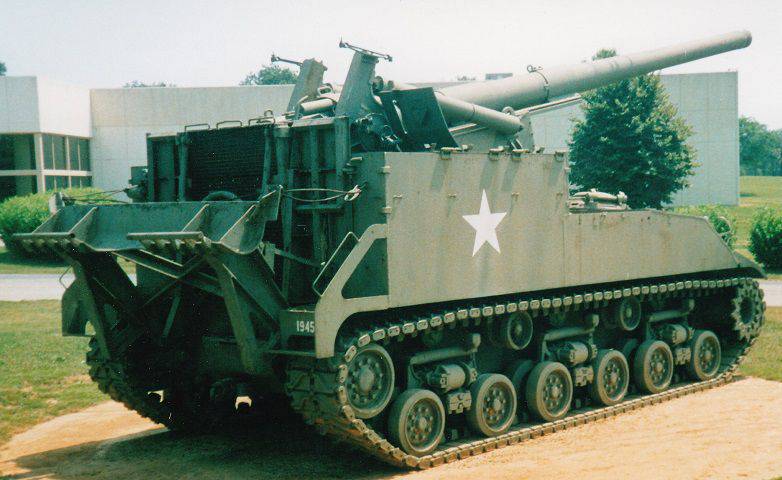
Aft part of the museum car. Photo Afvdb.50megs.com
The development of the T83 GMC project was carried out in parallel with the modernization of existing M12, which led to the borrowing of some relatively new ideas. So, M12 initially had a not very reliable hydraulic drive of the feed coulter. In the course of the modernization, she received a system with a cable and a winch, which provided the relative convenience of raising and lowering the opener. T83 received a similar stubborn device. To maintain a stable position when shooting, she received a lowered coulter with a rope-like lifting mechanism. A metal plate was installed on the upper part of the opener mounts, which increased the area of the fighting compartment during the shooting. In the transport position, this plate was the aft wall of the fighting compartment.
The crew of a promising self-propelled gun consisted of eight people. The two, the driver and commander, were located in front of the hull. The calculation of the instrument consisted of six people. During the march, they were supposed to be in the aft fighting compartment, and when they participated in combat work, some calculation numbers went down to the ground and were engaged in preparing ammunition, or working with a projectile conveyor.
As in the case of the M12, additional weapons installed on the armored vehicle, was not provided. In the event of a collision with an enemy, the self-propelled crew was asked to use personal weapons, as well as hand and rifle grenades.
Despite the widespread use of existing components and assemblies, the new ACS was markedly different from the base tank in its dimensions and weight. The length (without a gun) was 7,12 m, width - 3,15 m, height (at the upper point of the gun mount) - 3,3 m. The combat weight was 37 t, which was associated with the use of a rather heavy gun.
Used 340-strong engine could not provide 37-ton machine with high mobility. However, even with the available characteristics, the T83 GMC could move on a highway and rough terrain. The maximum speed on a good road reached 35-40 km / h. At the same time, however, the movement at speeds of the order of 40 km / h could continue only for a short time. The fuel supply was enough for 160 km of the way on the highway. An intersection of a moat with a width of 2,3 m, ascent to the slope of a steep 60% or to a 61-cm wall was provided. Shallow (up to 1 m) water barriers could be crossed ford.
In parallel with the self-propelled artillery installation T83, an ammunition transporter was created, designated T30. It was developed on the basis of ACS and had a similar design. The main difference of this machine was the absence of a stern coulter and gun in the fighting compartment, in the place of which there were racks for a large number of ammunition. Later, during the development of self-propelled artillery systems, a modification of the T30 vehicle was created, designed to transport shells of various calibers. It differed from the original version by using universal shelves for 105-, 155-, 203- and 240-mm projectiles.
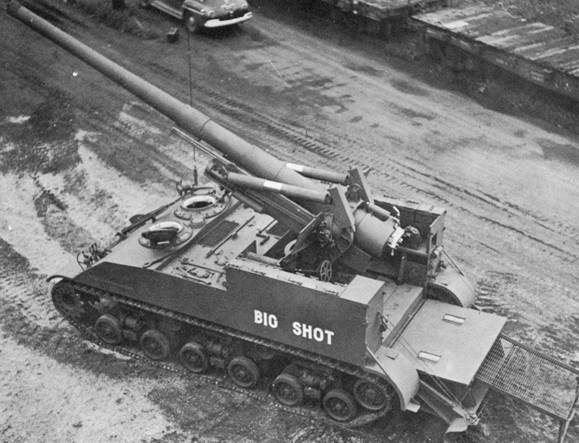
M40 in a combat position with a low coulter lowered and a raised tool. Photo Vn-parabellum.com
The development of the T83 GMC project started in January of 1944, but soon faced a number of administrative difficulties. Despite the obvious benefits from the construction and use of self-propelled artillery, the command of the US ground forces did not want to finance the creation and assembly of such equipment. Nevertheless, the command of artillery and armored forces was able to defend a promising idea, thanks to which, in particular, it was possible to begin the construction of an experimental self-propelled gun.
In March, 44-th completed the development of the project, after which the company Pressed Steel Car received an order for the construction of prototypes T83. In late spring, this car came to the test and soon showed all its positive qualities. The use of solutions worked out in the course of the previous project made it possible to immediately create a fairly advanced model of military equipment. Due to this, already by the middle of the summer the ACS T83 was ready for commissioning and serial construction.
At the insistence of the artillery command, in July 1944, shortly after the landing in Normandy, an order was placed for the so-called. limited production of a new artillery complex consisting of T83 self-propelled guns and a T30 transporter. It was planned to build two types of 304 machines. This equipment was assembled by the specialists of Pressed Steel Car.
Execution of the first order faced noticeable difficulties. For use at the front required the maximum possible number of tanks M4 Sherman, which imposes certain restrictions on the construction of equipment at its base. For this reason, in the summer and autumn, several T30 transporters were built, after which their production actually stopped. The military and industry officials considered that the existing chassis should be used for the construction of self-propelled guns, and the production of auxiliary equipment can be sacrificed. It should be noted that it was after this that a proposal appeared to create a universal ammunition transporter capable of transporting various shells of caliber from 105 to 240 mm. According to the results of disputes, analyzes and consultations in December 1944, the order for production of T30 was canceled. Universal version of the conveyor did not go to the series.
In January, Pressed Steel Car completed the first contract and handed over to the customer all 304 SAUs of the new model. After short military tests and some bureaucratic procedures, self-propelled guns were adopted. In March, 1945, the T38, was put into service under the designation M40 Gun Motor Carriage. In the future, an informal nickname appeared. His self-propelled gun inherited from the used guns: Long Tom.
After the construction of the first batch was completed, it was decided to order another 296 self-propelled artillery, bringing their total to 600 units. Due to certain circumstances, until the end of hostilities in Europe, only seven vehicles of the second batch were built. After the end of the war at the European theater, the assembly of machinery continued, new cars left the assembly line until the end of 1945.
From February to December 1945, the company Pressed Steel Car built 144 ACS M40 GMC, after which the assembly of such equipment was stopped. In total, over a year the army received 448 armored vehicles with 155-mm guns and several ammunition transporters.
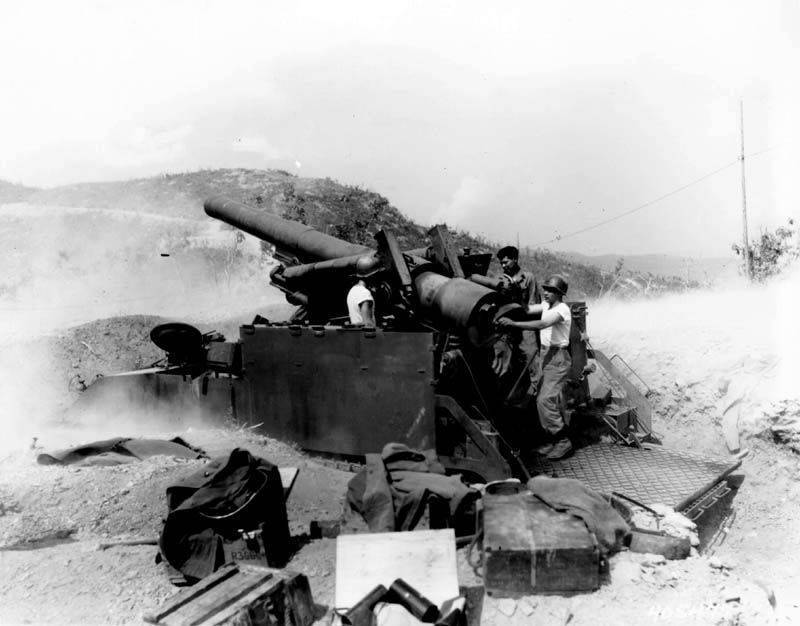
ACS M43 HMC based on M40. Photo of Wikimedia Commons
The ACS of the first batch was handed over to the troops at the start of the 45, and soon after that part of the equipment went to the front. Self-propelled guns were reduced to batteries of four cars, united in divisions. For the first time M40 took part in the battles at the end of February, during the battles on the approaches to Cologne. There, this technique solved the tasks of direct support of the attacking troops with direct fire, and also bombarded targets from closed positions, being at some distance from the front edge. The active use of new self-propelled guns allowed us to strengthen field and howitzer artillery, as well as to increase the mobility of compounds.
M40 GMC with a certain activity was used until the end of the fighting in Europe, after which all remaining machines of this type were returned to the United States or distributed among the "European" units of the American army.
After the end of the war in Europe, M40 self-propelled guns became the basis for new M43-type vehicles armed with 203-mm guns. By order of the army, re-equipment with the installation of new weapons were 48 serial M40. Also on the basis of M40 developed self-propelled gun with 250-mm mortar. This car was built only in one copy.
After the end of World War II, the artillery units of the American army continued to operate the M40 GMC machines. For some time, the write-off of this technique was not considered expedient, which is why it remained in the army until the early fifties. This allowed M40 self-propelled guns to take part in the Korean War. A number of such equipment was used during the fighting on the Korean Peninsula. In addition, in this conflict, American troops used ACN M43. As during World War II, this technique was used to fire at enemy targets from long distances, as well as to directly support troops on the battlefield.
In the postwar period, a number of American cars were transferred to the British army, where they received the designation 155 mm SP M40 Cardinal. The operation of this technique continued until the appearance of new models with enhanced characteristics.
Late modifications of the M4 Sherman medium tank were operated by the United States until the second half of the fifties. After that, a massive write-off of outdated equipment began, under which self-propelled guns like M40 fell. They no longer met modern requirements, and also had an insufficient resource, and therefore were written off over time. The vast majority of M40 Gun Motor Carriage was disposed of as unnecessary. Up to our time no more than a dozen cars survived, which are exhibits of museums in the USA, Great Britain and Germany.
On the materials of the sites:
http://afvdb.50megs.com/
http://vn-parabellum.com/
http://militaryfactory.com/
http://battletanks.com/
http://wwiivehicles.com/
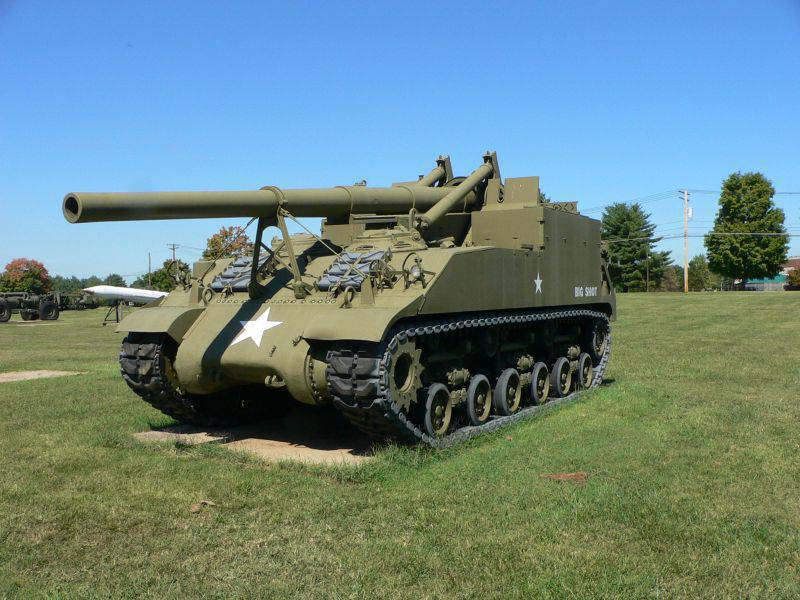
Information